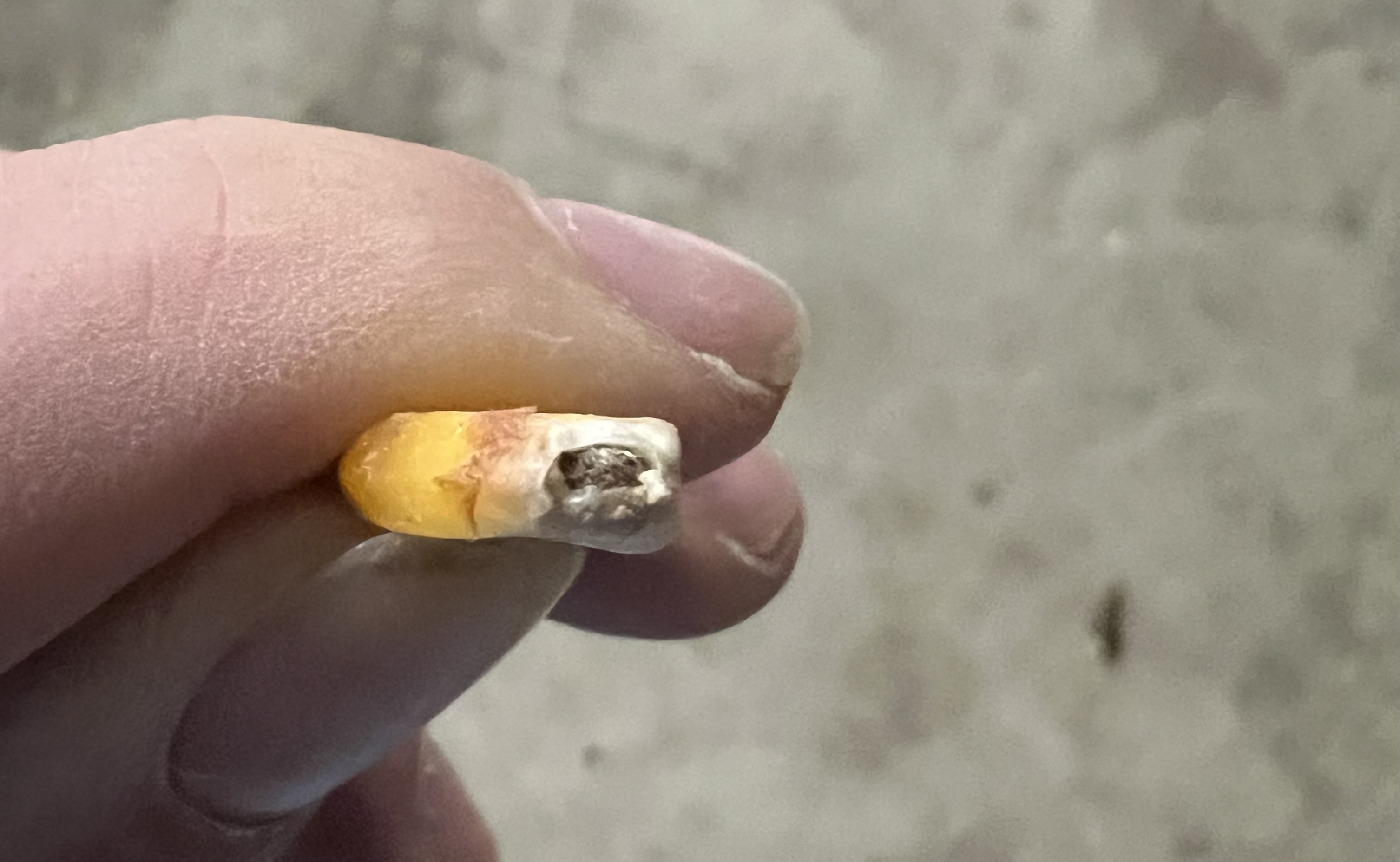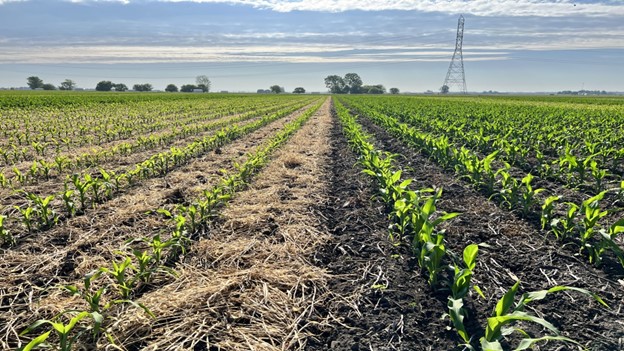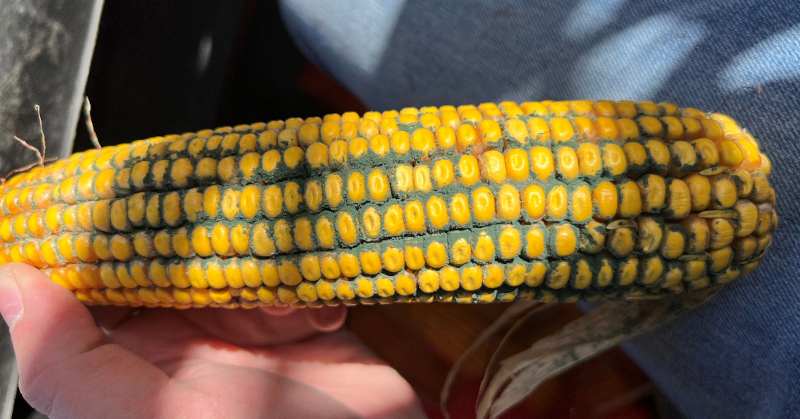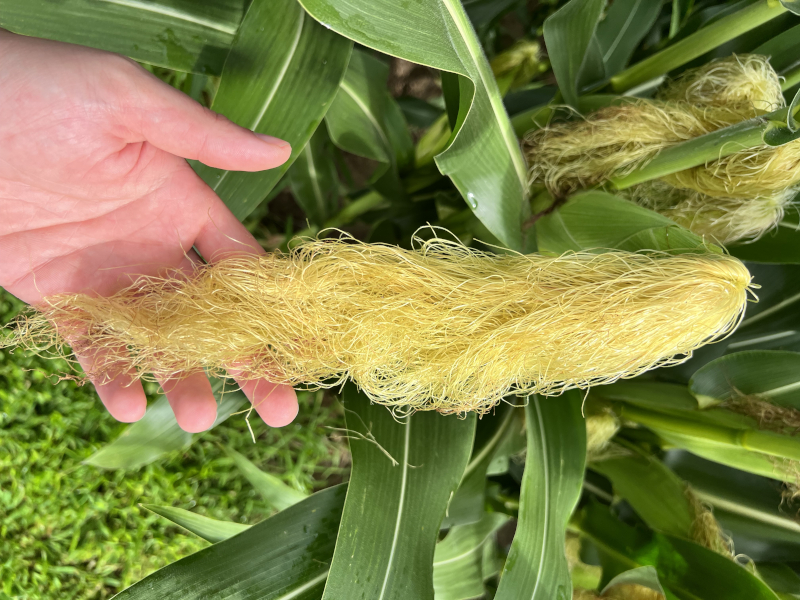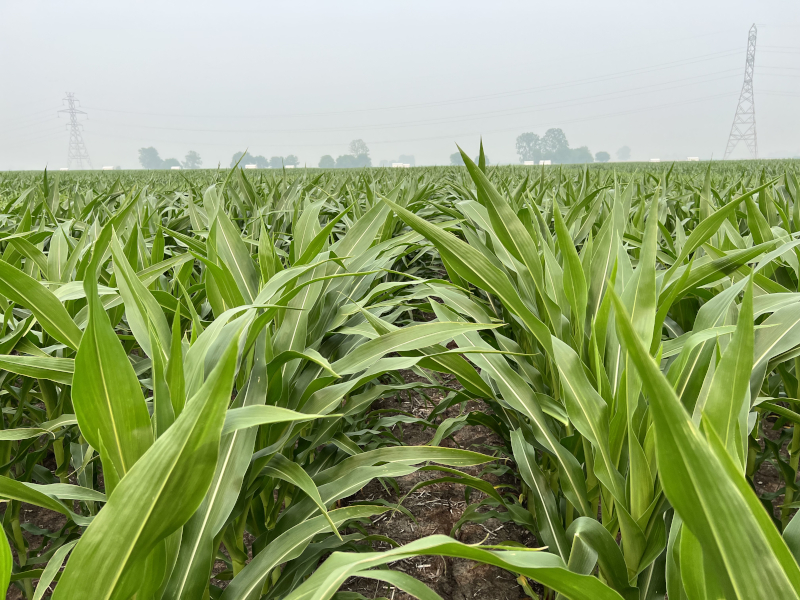
Image 1: Corn planted following a cereal rye cover crop in a Kentucky no-till system.
Dan Quinn, Hanna Poffenbarger, and Chad Lee
Dept. Plant and Soil Sciences, University of Kentucky
Introduction
A cover crop is a plant species that is grown between cash crops primarily to provide cropping system services rather than to produce a harvestable product. Services provided by cover crops include soil health improvement, soil conservation, nutrient release and capture, and weed suppression. However, like any management practice, cover crops also have challenges and limitations. This publication is intended to provide an overview of cover crop use in Kentucky and the challenges and benefits of this practice. As more research is completed, we expect additional publications to address specific management questions regarding cover crops.
Historically, many growers in Kentucky planted wheat cover crops following tobacco harvest. The two most common crop rotations in grain crops in Kentucky are corn one summer and soybean the next (corn-soybean) or corn one summer, winter wheat seeded that fall and harvested the next June, followed by soybeans immediately after the wheat (corn-wheat-double crop soybean). Since 2000, an average of 39% of the corn acres are seeded to winter wheat. The remaining corn acres and all the soybean acres are excellent candidates for cover crops.
Many plant species can be used as winter cover crops in Kentucky. These include small grains like cereal rye or winter wheat, brassicas (radishes), clovers, and annual ryegrass. Cereal rye is particularly popular due to its hardy growth, ability to survive winter and rapid growth in the spring. Annual ryegrass is a different species than cereal rye. Annual ryegrass has some promising effects on fragipan soils and has excellent forage quality. But, annual ryegrass is an extremely aggressive weed in wheat and should be avoided on all farms with wheat in the rotation. The brassicas (radishes) and legumes (clovers) do not have the fibrous root system or the ability to survive some winters compared to cereal rye or wheat.
Cover crops can be established successfully after corn or soybean harvest most years in Kentucky. Alternatively, a cover crop may be interseeded during early growth of the previous cash crop or broadcast just before leaf drop of the previous cash crop. Interseeding places seed in the soil when corn is about two feet tall. An interseeded cover crop must not be too aggressive to become a weed during corn growth, but also must be hardy enough to survive into winter. The success of broadcast seeding is very dependent on timely rainfalls, which improve seed to soil contact and germination. In most cases the cover crop is terminated shortly before or after corn or soybean planting the following spring. The timing of cover crop termination provides certain benefits and challenges which will be discussed throughout.
Table 1. Example of plant species used as cover crops.
| Common Name | Family | Scientific name | Cover crop attributes |
| Cereal Rye | Grass | Secale cereale | Well-suited to fall planting. Fibrous root system holds soil together. High biomass production and weed suppression potential. Strong establishment potential. High nutrient capture, low nutrient release. |
| Winter Wheat | Grass | Triticum aestivum | Well-suited to fall planting. Fibrous root system holds soil together. Produces less biomass than cereal rye. Low seed cost. |
| Annual ryegrass | Grass | Lolium multiflorum | Potential for improving productivity of fragipan soils. Excellent forage quality. Strong establishment potential. Can be difficult to terminate. Aggressive weed in wheat and therefore not recommended for fields that may be rotated to winter wheat. |
| Daikon Radish | Brassica | Raphanus sativus var. longipinnatus | Large tap root. Potential to alleviate some soil compaction. High nutrient capture, low nutrient release. Likely will not survive winter. Will not impede spring planting of the cash crop. Minimal weed suppression. High seed cost. |
| Turnip | Brassica | Brassica rapa, Brassica spp. | Potential to alleviate some soil compaction. Likely will not survive winter. Will not impede spring planting of cash crop. High seed cost. |
| Crimson Clover | Legume | Trifolium incarnatum | Legume that will fix and contribute some N to subsequent cash crop. Low soil nutrient capture. Minimal weed suppression potential. High seed cost. |
| Hairy Vetch | Legume | Vicia villosa | Legume that will fix and contribute some N to subsequent cash crop. Produces more biomass than crimson clover. Can be difficult to terminate and plant into. High seed cost. |
Cover Crop Benefits
- Soil erosion prevention – Winter cover crops provide an actively growing surface barrier holding soil in place and preventing soil erosion during winter and early spring months when most cash crops are not growing. Grass cover crops such as cereal rye, winter wheat, and annual ryegrass produce large, fibrous root systems which help hold the soil together. The loss of topsoil decreases soil productivity and increases the amount of sediment in surface water systems.
- Uptake and storage of environmentally harmful nutrients – Excess soil nutrients such as nitrogen and phosphorus can be lost from the soil and contaminate water resources. Most cover crops have deeper rooting systems than winter annual weeds, allowing the cover crops to uptake residual fertilizer and nutrients released from soil organic matter. Cover crops can store those nutrients and possibly recycle them to the following cash crop. Cover crops such as cereal rye can reduce soil nitrate levels in drainage water by approximately 50%.
- Improved soil water infiltration and retention – Cover crops can help provide a buffer for increasing weather variability that causes both saturated and drought soil conditions. As they grow, cover crops use water, which reduces soil saturation following high rainfall. Cover crop roots explore the soil during periods of the year when the ground is relatively soft, establishing root channels that can be used by cash crop roots during drier summer months. In addition, research in Kentucky has shown annual ryegrass, a different species from cereal rye, has the potential to ameliorate fragipan soils through the release of chemical compounds from the roots. Following termination, cover crop residue helps to increase infiltration by preventing surface sealing and slowing runoff. In addition, cover crop residue can reduce the rate of soil water evaporation, improving water retention under drought conditions.
- Increased soil organic matter – After termination, cover crop shoots and roots decompose, release nutrients and stimulate microbial activity and soil aggregate formation. During this process, a portion of the cover crop residue becomes incorporated into the soil as organic matter. Soil organic matter benefits crop growth by storing and supplying nutrients to plants, improving soil tilth, and increasing plant-available water content.
- Plant nitrogen contributions – Legume cover crops such as crimson clover and hairy vetch can biologically fix nitrogen from the atmosphere and supply that nitrogen to the soil, thus reducing the need for synthetic nitrogen fertilizer inputs. A hairy vetch cover crop in Kentucky can produce a nitrogen fertilizer equivalency of 67 lbs. per acre for corn. Depending on temperature and moisture conditions, release of nitrogen from the legume into plant-available forms can take several weeks to months for nitrogen from the legume cover crop to be released into plant-available forms. Unfortunately, many studies that have reported large nitrogen contributions from legume cover crops delayed corn planting to allow more time for legume growth and nitrogen fixation. Currently, studies in Kentucky are ongoing to more accurately predict how much nitrogen a farmer could expect from a legume cover crop.
- Weed suppression – Cover crops can reduce weed biomass both during growth due to competition, and following termination by producing a weed-suppressive mulch. Cover crops with rapid establishment and high biomass potential such as cereal rye and annual ryegrass can reduce winter weed biomass and density as much as 50 to 100% prior to spring cash crop planting. However, farmers must be cautious with annual ryegrass as it is an aggressive weed in winter wheat and should not be used on farms where wheat is part of the rotation. Research in Kentucky has determined that if cover crop biomass is high enough, farmers may be able to eliminate either a pre-plant residual or a post-emergence herbicide application. High biomass cover crops can provide a longer window of weed control and reduce the risk of weed resistance development from a post-emergence application of glyphosate. In contrast, legume cover crops such as crimson clover do not provide strong weed control due to slower growth, reduced biomass, and fast decomposition following termination. However, grass-legume cover crop mixtures can be highly productive in combining both weed suppression and nutrient supply benefits to the subsequent cash crop.
Cover Crop Challenges
- Nitrogen Management – Cover crops growing in the fall will capture residual fertilizer nitrogen and plant-available nitrogen that is released from soil organic nitrogen stocks. When the cover crop is terminated, it will decompose and release some nitrogen that will be available to the next cash crop, while other nitrogen will be incorporated into microbes. When the carbon to nitrogen (C/N) ratio is high (about 25:1 or greater), a greater proportion of the N is incorporated into microbial biomass and less is available for the cash crop. Cereal rye biomass can produce a high C/N ratio. Studies are ongoing to determine how these nitrogen dynamics following cereal rye affect nitrogen management in the following corn crop. Some farmers assume they need to apply an extra 25 to 50 pounds of nitrogen per acre to corn following a cereal rye cover crop. Legumes capture greater amounts of nitrogen than non-legume cover crops because they derive nitrogen from biological nitrogen fixation as well as from the soil. While previous studies show legumes contribute as much as 45 to 100 pounds of nitrogen per acre to the cash crop, the actual amount depends on the cover crop biomass, the C/N ratio, the termination date of the cover crop and other factors. Predicting how much nitrogen we can expect from the legume cover crop is extremely difficult. Again, research is ongoing to better define the legume contribution of N to the cash crop.
- Termination challenges – Attributes that make a plant a good cover crop (e.g., root biomass production, aboveground biomass production, rapid establishment and growth, etc.) can also make the cover crop a major pest if not controlled properly. For example, Kentucky farmers utilizing annual ryegrass as a cover crop need to be aware of the spring termination difficulties associated with the cover crop due to its growth potential. Farmers should avoid using this cover crop in wheat rotations due to its capability of becoming a major pest in wheat. If not terminated properly prior to cash crop planting, cover crops can become weeds in the ensuing cash crop as well as produce seeds and establish a seed bank resulting in future weed problems.
- Unfavorable soil moisture conditions at planting – In dry springs, growing cover crops can deplete the soil profile of water needed for cash crop germination and growth. Therefore, the cover crop should be terminated earlier in dry springs to minimize water loss from the soil. In wet springs, cover crop residue on the soil surface can reduce the evaporation rate of water from the soil, thus keeping the soils too wet to plant for extended periods of time.
- Delayed or reduced crop emergence – Related to soil moisture challenges, cover crop residue can delay soil warming. Delayed soil warming can make planting more difficult, delay time of planting, delay crop emergence, and ultimately reduce cash crop establishment and yield.
- Residue equipment interference – Thick residue coverage formed by a cover crop can cause planter interference, poor furrow closure, and poor seed to soil contact of spring- planted cash crops. Additional equipment on the planter (e.g. row cleaners or coulters) and/or additional passes with other equipment (e.g. strip tillage equipment, roller crimpers, etc.) may be needed to combat cover crop residue during spring planting. Some farmers create strips with row cleaners a week or two prior to planting and terminate the cover crop near planting to remedy this. Others terminate the cover crop at least two weeks prior to planting to minimize residue interference. Whereas, some plant directly into green cover crops and terminate following planting as a method to handle residue. The right method likely depends on the weather and cover crop biomass each season. Farmers need to ensure that the planter is cutting through the cover crop residue and into the soil, placing the seed at the proper depth, and providing proper furrow closure. Whether farmers use strip tillage, row cleaners, earlier termination or other methods is a situational decision.
- Increased seedling disease presence – Certain cover crops are hosts to various soil pathogens, which increases pathogen populations. This could increase the risk of seedling diseases, which reduce plant populations, emergence, and yield. Cereal rye and other grasses can increase corn seedling disease potential, especially if the cereal rye cover crop is terminated less than two weeks prior to corn planting. Studies are currently ongoing in this area.
- Increased pest and animal pressure – Actively growing cover crops can provide habitat and cover for certain insects, slugs, and voles, thus increasing pest populations. For example, a cereal rye cover crop can significantly increase field armyworm populations resulting in corn injury and yield loss. Increases in slugs will attract small animals such as skunks and raccoons, which will dig for these and other pests and kill young corn plants. These animals prefer to walk in fields with heavy residue.
- Increased cost, labor and management – Winter cover crops require additional cost and labor for cover crop seed and planting. If the spring cash crop planting requires additional equipment or additional passes of strip tillage or roller crimpers, these are additional costs and labor. If the cover crop requires additional nitrogen or reduces the stand of the cash crop, these are expenses. A cover crop will appear as expenses on the cropping systems budget. The benefits to long-term soil improvement are difficult to quantify in the short-term, but these values must be incorporated into the economics.
Summary
Kentucky farmers were pioneers in no-tillage farming. Despite all the benefits of no-tillage farming, there are still challenges with the practice. Yet, most grain fields in Kentucky are either no-tillage or minimum tillage. Like no-tillage, there are some expected long-term benefits to cover crops; but there are some challenges as well. Ongoing research and continued trial and error on farms and conversations among farmers, crop consultants and university researchers will help us develop strong cover cropping practices that will help all of us protect our soils.
References
Acharya, J., M.G. Bakker, T.B. Moorman, T.C. Kaspar, and A.E. Robertson. 2017. Time interval between cover crop termination and planting influences corn seedling disease, plant growth, and yield. Plant Dis. 101:691-600.
Bakker, M.G., J. Acharya, T.B. Moorman, A.E. Robertson, and T.C. Kaspar. 2016. The potential for cereal rye cover crops to host corn seedling pathogens. Phytopathology 106:591-601.
Barberi, P., and M. Mazzoncini. 2001. Changes in weed community composition as influenced by cover crop and management system in continuous corn. Weed Sci. 49:431-499.
Basche, A.D., S.V. Archontoulis, T.C. Kaspar, D.B. Jaynes, T.B. Parkin, and F.E. Miguez. 2015. Simulating long-term impacts of cover crops and climate change on crop production and environmental outcomes in the Midwestern United States. Agric. Ecosyst. Environ. 218:95-106.
Blevins, R.L., J.H. Herbek, and W.W. Frye. 1990. Legume cover crops as a nitrogen source for no-till corn and grain sorghum. Agron. J. 82:769-772.
Dunbar, M.W., M.E. O’Neal, and A.J. Gassman. 2016. Increased risk of inject injury to corn following rye cover crop. J. Econ. Entomol. 109:1691-1697.
Duiker, S.W., and W.S. Curran. 2005. Rye cover crop management for corn production in the northern mid-atlantic region. Agron. J. 97:1413-1418.
Haramoto, E.R. 2019. Species, seeding rate, and planting method influence cover crop services prior to soybean. Agron. J. 111:1068-1078.
Haramoto, E.R., and R. Pearce. 2019. Cover crop termination treatment impacts weed suppression potential. Weed Sci. 67:91-102.
Kaspar, T.C., and M.G. Bakker. 2015. Biomass production of 12 winter cereal cover crop cultivars and their effect on subsequent no-till corn yield. J. Soil Water Conserv. 70:353-364.
Kuo, S., and E.J. Jellum. 2002. Influence of winter cover crop and residue management on soil nitrogen availability and corn. Agron. J. 94:501-508.
Legleiter, T., B. Johnson, T. Gordon, and K. Gibson. Successful cover crop termination with herbicides. Bull. WS-50-W. Purdue Extension. Purdue University. West Lafayette, IN.
Matocha, C.J., T.D. Karathanasis, L.W. Murdock, J.H. Grove, J. Goodman, and D. Call. 2018. Influence of ryegrass on physico-chemical properties of a fragipan soil. Geoderma 317:32-38.
Martin, J.R., C. R. Tutt and D.L. Call. 2010. Managing marestail and giant ragweed in wheat. Wheat Science Research Report: 2009-2010. Univ. of Kentucky. Lexington. https://wheatscience.ca.uky.edu/sites/wheatscience.ca.uky.edu/files/martin_-_managing_marestail_and_giant_ragweed_rr_09-10.pdf
Martinez-Feria, R.A., R. Dietzel, M. Liebman, M.J. Helmers, S.V. Archontoulis. 2016. Rye cover crop effects on maize: A system-level analysis. Field Crops Res. 196:145-159.
McSwiney, C.P., S.S. Snapp, and L.E. Gentry. 2010. Use of N immobilization to tighten the N cycle in conventional agroecosystems. Ecological Applications. 20:648-662.
Moore, E.B., M.H. Wiedenhoeft, T.C. Kaspar, and C.A. Cambardella. 2014. Rye cover crop effects on soil quality in no-till corn silage-soybean cropping systems. Soil Sci. Soc. Am. J. 78:968-976.
Poffenbarger, H.J., S.B. Mirsky, R.R. Weil, M. Kramer, J.T. Spargo, and M.A. Cavigelli. 2015. Legume proportion, poultry litter, and tillage effects on cover crop decomposition. Agron. J. 107:2083-2096.
Rutan, J., and K. Steinke. 2019. Corn nitrogen management following daikon radish and forage oat cover crops. Soil Sci. Soc. Am. J. 83:181-189.
Snapp, S.S., S.M. Swinton, R. Labarata, D. Mutch, J.R. Black, R. Leep, J. Nyiraneza, and K. O’Neal. 2005. Evaluating cover crops for benefits, costs and performance within cropping system niches. Agron. J. 97:322-332.
Snapp, S., and S. Surapur. 2018. Rye cover crop retains nitrogen and doesn’t reduce corn yields. Soil and Tillage Res. 180:107-117.
USDA-NASS. 2019. Quick Stats Database. United States Dept. of Agriculture. https://quickstats.nass.usda.gov/ accessed May 31, 2019.
Warren, J., K. Meeks, and J. Edwards. 2017. Benefits of using cover crops in Oklahoma no-till. Bull. PSS-2161. Oklahoma Cooperative Extension Service. Oklahoma State University. Stillwater, OK.
